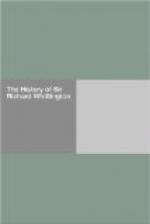Moreover in Sir Richard Whittington’s time lived one Richard Fleming, Bishop of Lincoln, in the year 1430 who founded Lincoln Colledge in Oxford, which was afterwards in Richard the third’s time in the year of our Lord 1479 by Thomas Rotherham Bishop of the same sea (sic) much augmented and enlarged with great revenues. Likewise Magdalen Colledge in Oxford was built by William Wainfleet Bishop of Winchester, who was a loving and constant friend to Sir Richard Whittington and did much good in many parts of this kingdom, and the said Sir Richard did largely contribute to these and the like pious uses by the intreaty of this Bishop.
In the year of our Lord 1419, in which Sir Richard Whittington was the third time inaugurated into the Mayoralty as is before mentioned King Henry the fifth, who having conquered the greatest part of France and espoused Katherine sole daughter to the King and heir to the crown, taking leave of his father-in-law, embarked with his Royal bride and landed at Dover upon Candlemas Day, leaving in France for his deputy his brother the Duke of Clarence, from thence arrived in London the fourteenth day of February, and the Queen came thither the one and twentieth day of the same month, being met upon Black-Heath by the Lord Mayor and three hundred aldermen and prime citizens in gold chains and rich costly habits with other sumptuous and brave devices as pageants, speeches and shows to the great delight and content of both their Maiesties.
The four and twentieth day of February following being St. Mathew’s Day her coronation was solemnized in St. Peter’s Church in Westminster; which being ended, she was afterwards royally conveyed into the great hall and there under a rich canopy of State sat to dinner, upon whose right hand sate at the end of the table the Lord Archbishop’s grace of Canterbury and Henry called the rich Cardinal Bishop of Winchester, upon the left hand of the Queen sat the King of Scots in a chair of State, and was served with covered dishes, as the Bishops were. But after them and upon the same side next to the Boards end were seated the Dutchess of York and Countess of Huntington, the Earl of March holding a scepter in his hand, kneeling upon the right side, the Earl Marshal in the like manner kneeled upon the left hand of the Queen: the Countess of Kent sat under the table at the right foot, and the Countess Marshal at the left foot of her Majesty.
Humphery Duke of Glocester was that day overseer and stood before the Queen bareheaded, Sir Richard Newel was carver and the Earl of Suffolk’s brother cup-bearer, Sir John Stewart, Sewer, the Lord Clifford (instead of the Earl of Warwick) Pantler, the Lord Willoby (instead of the Earl of Arundel) chief Butler, the Lord Gray Caterer, Naperer, the Lord Audley (in the stead of the Earl of Cambridge) Almner, the Earl of Worcester was Lord high Marshal, who rode about the Hall on a great courser, with many tip-staves about him to make room in the Hall. In the which




